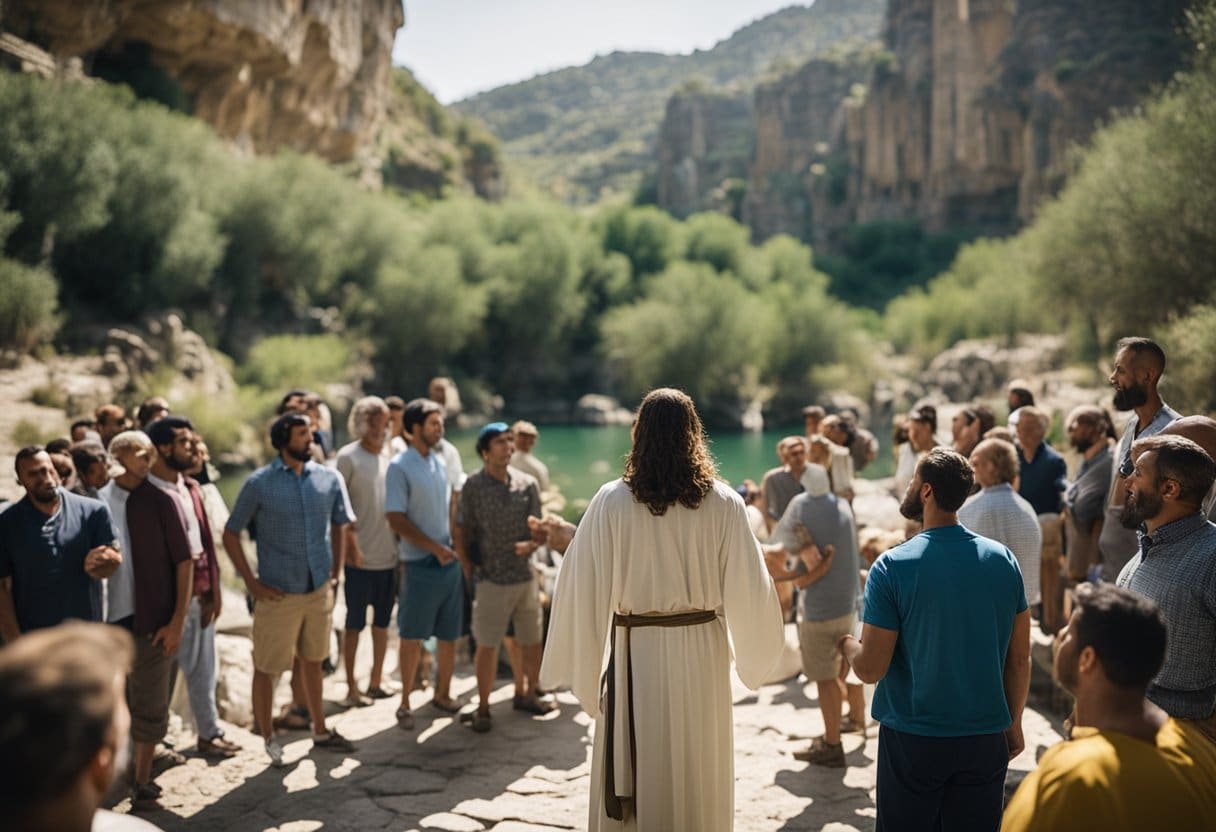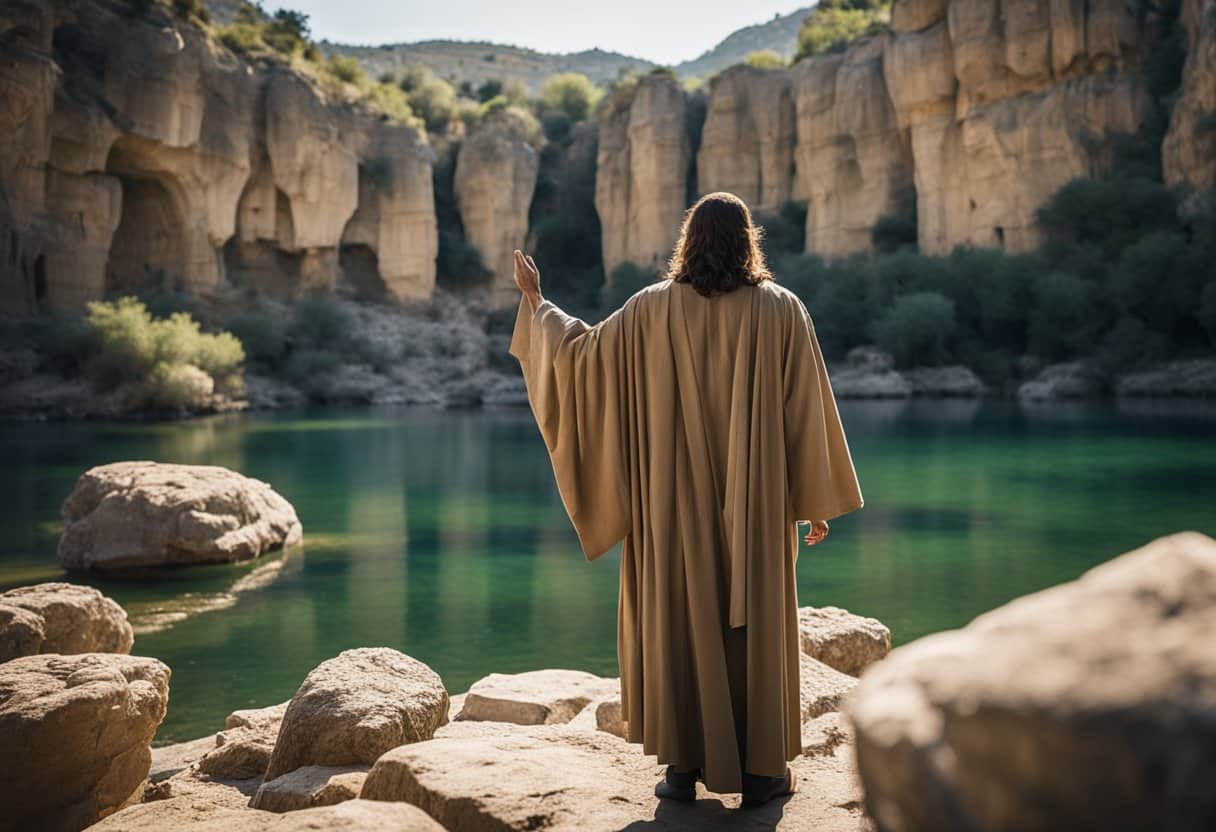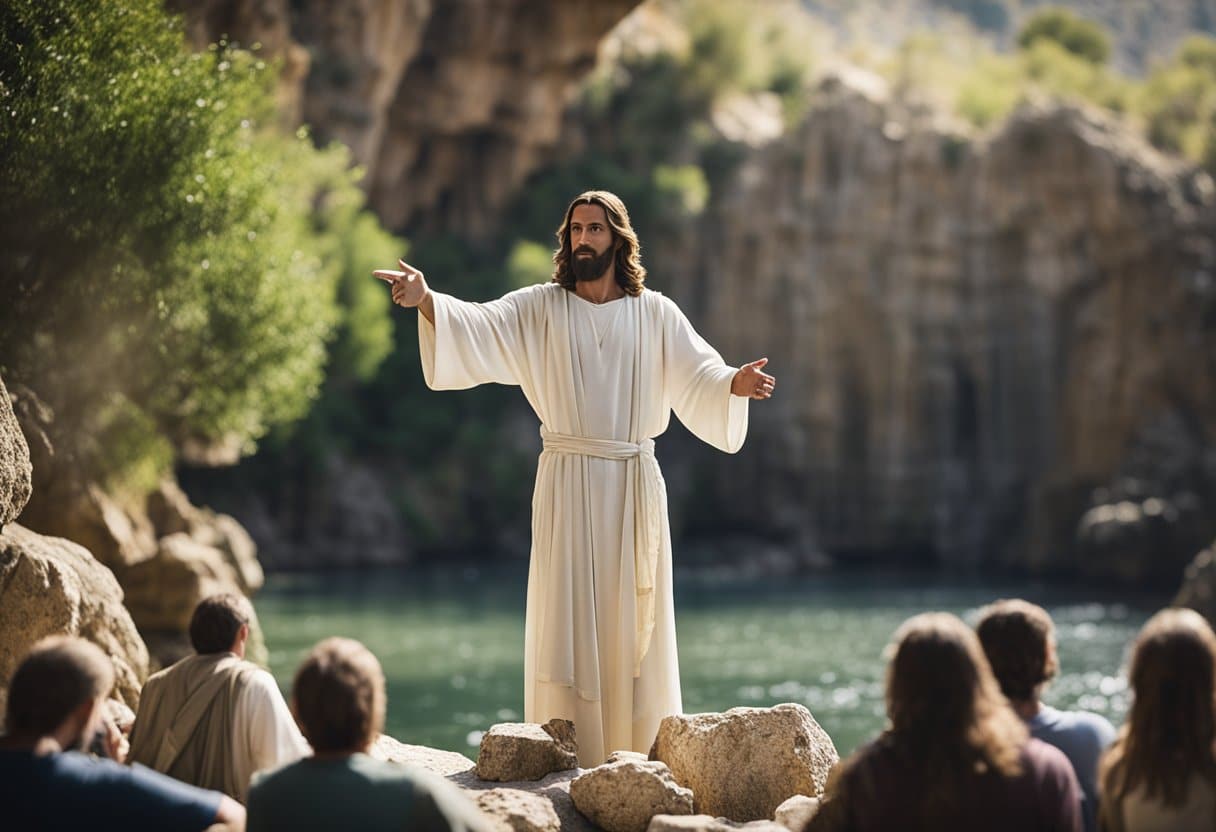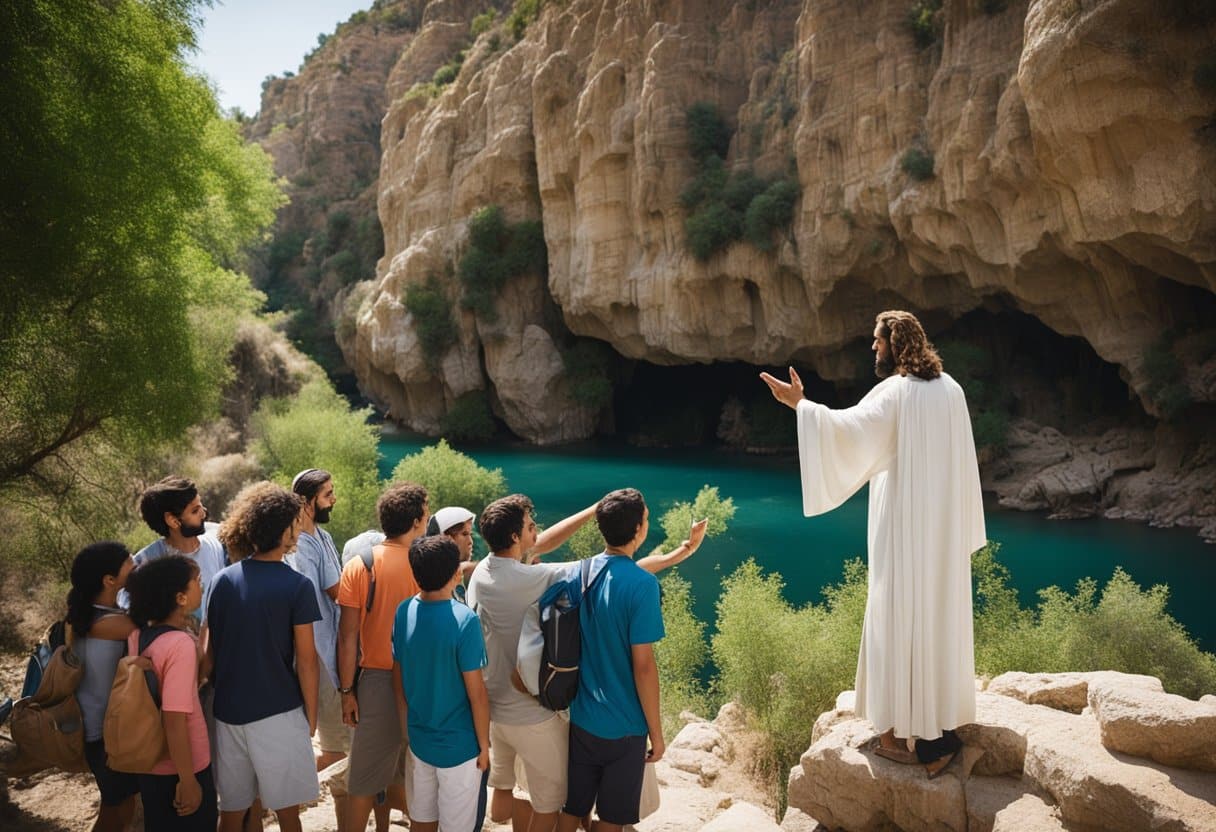If you’ve ever wondered why Jesus went to Caesarea Philippi, you’re not alone. This ancient city located in the northernmost part of Israel was known for its pagan worship and was considered by many to be the gateway to the underworld.
Despite this, Jesus chose to visit Caesarea Philippi with his disciples, and the events that unfolded there had a profound impact on his ministry.

According to the Bible, Jesus and his disciples arrived in Caesarea Philippi after spending time in Galilee. It was there that Jesus asked his disciples, “Who do people say that I am?” (Mark 8:27).
After they gave him various answers, he asked them directly, “But who do you say that I am?” (Mark 8:29). It was Peter who answered, “You are the Christ.”
This confession of faith was a turning point in Jesus’ ministry, and it marked the beginning of his journey to Jerusalem, where he would ultimately be crucified.
You may also like: How Jesus Christ Changed The World?
Historical Context of Why Jesus Went to Caesarea Philippi

Caesarea Philippi, now known as Banias, was a city located at the base of Mount Hermon in the northern region of Israel.
The city was named after Philip, the son of Herod the Great, who ruled over the region during the time of Jesus. It was also named after Caesar, the Roman emperor, who was worshipped as a god in the region.
Geographical Significance
Caesarea Philippi was a significant location due to its proximity to the Sea of Galilee and the Jordan River.
The natural spring near the city was the largest source of the Jordan River, making it an important source of water for the region. Rising above the city was Mount Hermon, which was considered a sacred site by the people of the region.
Cultural and Religious Melting Pot
The city was a cultural and religious melting pot, with influences from Greek, Roman, and Jewish cultures.
The people of the city worshipped various gods, including Pan, the Greek god of nature, who was believed to have lived in a grotto near the city.
The grotto of Pan was also known as the “Gates of Hades,” and was believed to be the entrance to the underworld.
The city was also home to a temple dedicated to Caesar, which was built by Herod the Great.
The temple was a symbol of Roman power and authority in the region. In addition, there was a temple dedicated to the god Baal, which was built by the Canaanites.
Theological Implications of Caesarea Philippi

Jesus’ journey to Caesarea Philippi had significant theological implications. Now, I will research the implications of Peter’s confession of faith and the keys to the kingdom of heaven.
Peter’s Confession of Faith
At Caesarea Philippi, Jesus asked his disciples, “Who do people say the Son of Man is?” (Matthew 16:13).
The disciples replied that some thought he was John the Baptist, Elijah, Jeremiah, or another prophet. Jesus then asked them, “But what about you? Who do you say I am?” (Matthew 16:15). Simon Peter answered, “You are the Christ, the Son of the living God” (Matthew 16:16).
Peter’s confession of faith was significant because it acknowledged Jesus as the Messiah, the Son of God. This confession was a turning point in the disciples’ understanding of Jesus’ identity.
It also showed that Jesus was not merely a prophet but the Son of God, with divine authority.
The Keys to the Kingdom of Heaven
After Peter confesses faith, Jesus says to him, “Blessed are you, Simon son of Jonah, for this was not revealed to you by flesh and blood, but by my Father in heaven.
And I tell you that you are Peter, and on this rock, I will build my church, and the gates of Hades will not overcome it.
I will give you the keys of the kingdom of heaven; whatever you bind on earth will be bound in heaven, and whatever you loose on earth will be loosed in heaven” (Matthew 16:17-19).
The keys to the kingdom of heaven represent the authority that Jesus gave to Peter and the disciples to proclaim the gospel and build the Church. This authority was not given to Peter alone but to all the disciples.
The Church was built on the foundation of Peter’s confession of faith, which recognized Jesus as the Christ, the Son of the living God.
Biblical Narratives and Symbolism

Mount Hermon and the Transfiguration
One of the reasons Jesus went to Caesarea Philippi was to climb Mount Hermon with his disciples Peter, James, and John.
According to Matthew 17:1-9, Jesus was transfigured before them, and his face shone like the sun, and his clothes became white as light. This event is known as the Transfiguration and symbolizes the glory of Christ.
It was a pivotal moment in the Gospels, as it affirmed Jesus’ divinity and connected him to the Law and the Prophets.
Mount Hermon is a significant location in the New Testament, as it represents the highest point in Israel and is associated with the presence of God.
The Transfiguration on Mount Hermon is a powerful symbol of the divine nature of Christ and his mission on earth.
The Confession at Caesarea Philippi
Another reason why Jesus went to Caesarea Philippi was to ask his disciples who they believed he was. In Mark 8:27-30, Jesus asks, “Who do people say that I am?”
His disciples reply that some say he is John the Baptist, while others say he is Elijah or one of the prophets. Jesus then asks, “But who do you say that I am?” Peter answers, “You are the Christ.”
This confession of faith is a turning point in the Gospel narratives, as it shows that the disciples have recognized Jesus as the Messiah. It also sets the stage for Jesus’ subsequent teachings about his impending death and resurrection.
The location of this event is significant, as Caesarea Philippi was a center of pagan worship and a symbol of the forces of evil.
Jesus’ declaration of his identity as the Christ in this location is a powerful symbol of his victory over evil and his mission to save humanity.
These events symbolize the divine nature of Christ and his mission on earth, as well as his victory over evil and his role as the savior of humanity.
Jesus’ Ministry and Teachings
Throughout his ministry, Jesus traveled to many cities, villages, and towns in Galilee, healing the sick and teaching the people.
He performed many miracles, demonstrating his power over nature and illness. Jesus’ ministry was characterized by his compassion for the people, and his desire to ease their suffering.
Miracles and Healing
Jesus’ healing miracles were a central part of his ministry. He healed people suffering from various illnesses, including blindness, deafness, and leprosy.
In one instance, he healed a paralyzed man who was lowered through the roof of a house where Jesus was teaching. Jesus not only healed people physically but also spiritually, forgiving their sins and restoring their relationship with God.
Confrontation with Evil
Jesus’ ministry was not without opposition. Satan and his demons sought to undermine Jesus’ mission, and he often confronted them directly.
In one instance, Jesus cast out demons from a man who had been possessed for a long time. He also confronted the religious authorities in Jerusalem, who were threatened by his teachings and miracles.
Contemporary Relevance and Reflection

Lessons for Modern Believers
As a modern believer, Jesus’ visit to Caesarea Philippi teaches us several lessons.
Firstly, it reminds us of the importance of knowing and confessing Jesus’ identity. Just as Jesus asked his disciples “Who do you say that I am?” (Matthew 16:15), we too must have a clear understanding of who Jesus is and what he means to us.
Additionally, the visit to Caesarea Philippi reminds us of the importance of standing firm in our faith, even in the face of opposition from those who may not share our beliefs.
Furthermore, the visit to Caesarea Philippi can serve as a reminder of the dangers of evil and the need to resist it. In Caesarea Philippi, there were many pagan temples and shrines dedicated to various gods.
Jesus’ visit to this city can remind us of the importance of staying true to our faith and not being swayed by the temptations of the world.
Archaeological and Touristic Interests
Caesarea Philippi is located in modern-day Israel and is a popular tourist destination. The ancient city is home to several historical and archaeological sites, including the Banias Nature Reserve, which is home to beautiful waterfalls and springs.
Visitors to the area can also visit the remains of the ancient city, including the ruins of the temple of Pan and the grotto of Pan.
Moreover, Caesarea Philippi’s significance in the Bible makes it an important destination for Christians. The city’s association with Jesus Christ and his teachings makes it a popular pilgrimage site for believers.
The reason why Jesus went to Caesarea Philippi can help deepen one’s understanding of the Christian faith and provide an opportunity for reflection and spiritual growth.
In conclusion, the visit to Caesarea Philippi is significant for many reasons. For modern believers, it serves as a reminder of the importance of knowing and confessing Jesus’ identity and standing firm in our faith.
Additionally, Caesarea Philippi’s archaeological and touristic interests make it a popular destination for visitors to the area.
